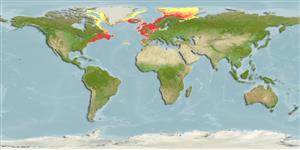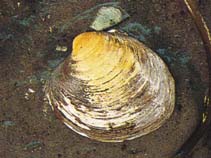Arctica islandica (Linnaeus, 1767)
Ocean quahog| Native range | All suitable habitat | Point map | Year 2050 |

|
| This map was computer-generated and has not yet been reviewed. |
| Arctica islandica AquaMaps Data sources: GBIF OBIS |
Classification / Names Common names | Synonyms | CoL | ITIS | WoRMS
| Venerida | Arcticidae
Environment: milieu / climate zone / depth range / distribution range Ökologie
; tiefenbereich 0 - 482 m (Ref. 88171). Temperate, preferred 7°C (Ref. 107945); 77°N - 35°N, 120°W - 45°E
Verbreitung Länder | FAO Gebiete | Ecosystems | Vorkommen | Einführungen
Northern Atlantic and the Arctic: from Bay of Cadiz Spain, north to Iceland, and from Cape Hatteras in North Carolina, USA to the Canadian Arctic. Subtropical to polar.
Length at first maturity / Size / Gewicht / Alter
Maturity: Lm ?, range 2 - 4.1 cm Max length : 13.0 cm SHL Männchen/unbestimmt; (Ref. 88171); common length : 7.6 cm SHL Männchen/unbestimmt; (Ref. 360)
Kurzbeschreibung Morphologie
Shell: moderately swollen, thick and robust valves, almost circular, equivalved and inequilateral; has a thick dark brown to blackish periostracum; sculpture consists of thin concentric grooves; well-developed external ligament, reaching the end of the posterior margin of the valve, posterior to the umbones; hinge is heterodont, right and left valves each has three cardinal teeth, anterior and posterior lateral teeth; inside the valves are two slightly different muscle scars (dimyarian, anisomyarian), linked by a continuous pallial line (integropalliate), without a sinus; crossed-lamellae structure. Body: pair of gills each consists of two series of lamellae extensively linked by interlamellar junctions (eulamellibranch); foot is large and the two mantle lobes fuse to form two stout siphons.
Minimum depth from Ref. 7726. Maximum shell height at 13 cm (anterior-posterior: from the whorl to opposite shell edge) in the Northeast Atlantic. Considered one of the slowest growing clam species in the world and extremely long-lived with an age record of 374 years. As an endobenthic species, population threats include anthropogenic factors such as mechanical damage, oxygen deficiency/eutrophication, unintentional habitat dislocation, temperature and osmotic stress brought by climate change, and, on a major scale, increased trawl fishery in the North Atlantic (Ref. 88171). Prefer a temperature range of 1° to 18°C and, although found in brackish waters with salinity levels of 14 and higher, is intolerant of salinities below 10. Found in both shallow and deep waters with preferred depth range between 10 and 280 m. Having a short siphon, it buries shallow beneath the surface, in gravelly, sandy to muddy sediments, and sapropels but preferentially in fine, silty sediment. Maintains a stationary position once it has settled onto the substrate. May burrow below the sediment surface possibly to escape predators or to conserve energy by going into this anaerobic phase which can last up to 7 days. A suspension and detritus feeder on fresh organic matter; filters phytoplankton and able to pick up food particles from the seabed with the tentacles on the end of its siphon, it being a suspension feeder. Dioecious with reproduction continuous throughout the year. Late sexual maturity, at around 5 to 11 years, make its population sensitive to disturbance (Ref. 88171).
Life cycle and mating behavior Geschlechtsreife | Fortpflanzung | Ablaichen | Eier | Fecundity | Larven
Members of the class Bivalvia are mostly gonochoric, some are protandric hermaphrodites. Life cycle: Embryos develop into free-swimming trocophore larvae, succeeded by the bivalve veliger, resembling a miniature clam.
Hauptreferenz
Referenzen | Koordinator | Partner
Harvey-Clark, C. 1997. (Ref. 7726)
IUCN Rote Liste Status (Ref. 130435)
CITES Status (Ref. 108899)
Not Evaluated
CMS (Ref. 116361)
Not Evaluated
Bedrohung für Menschen
Nutzung durch Menschen
Fischereien: kommerziell
FAO - Fischereien: landings, Artbeschreibung | FishSource | Sea Around Us
Tools
Mehr Information
Internet Quellen
BHL | BOLD Systems | CISTI | DiscoverLife | FAO(Fischereien: Artbeschreibung; publication : search) | Fishipedia | GenBank (Genom, nucleotide) | GloBI | Gomexsi | Google Books | Google Scholar | Google | PubMed | Tree of Life | Wikipedia (Gehe zu, Suchen) | Zoological Record
Estimates based on models
Preferred temperature
(Ref. 115969): 6.6 - 10.9, mean 9.8 (based on 204 cells).
Widerstandsfähigkeit
(Ref. 69278):
niedrig, Verdopplung der Population dauert 4,5 - 14 Jahre. (K=0.02-0.2; tm=4.5).
Prior r = 0.47, 95% CL = 0.31 - 0.70, Based on 1 full stock assessment.
Nutrients: Calcium = 149 [71, 228] mg/100g; Iron = 8.53 [1.95, 15.11] mg/100g; Protein = 9.88 [8.64, 11.12] %; Omega3 = 0.313 [0.202, 0.423] g/100g; Selenium = 61 [50, 72] μg/100g; VitaminA = 0 μg/100g; Zinc = 2.04 [0.56, 3.51] mg/100g (wet weight).



